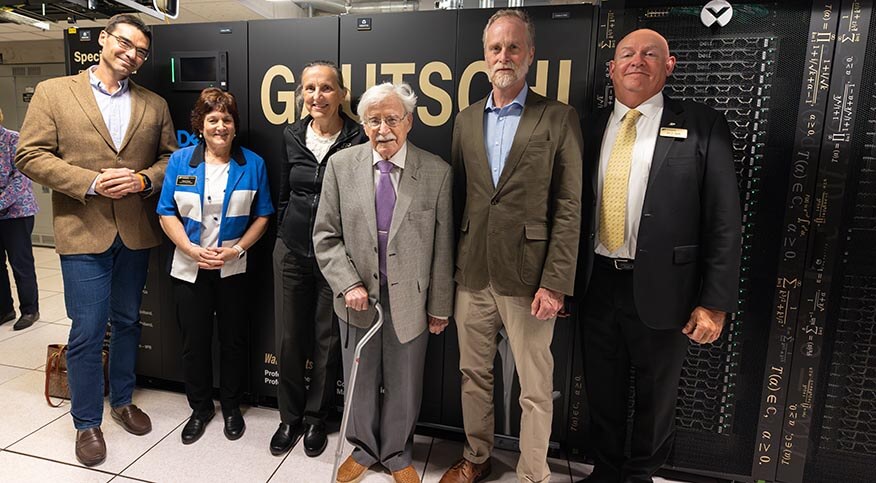The Gautschi supercomputer unveiled in dedication ceremony

Last week, the Rosen Center for Advanced Computing (RCAC) held a dedication ceremony for its newest community cluster, Gautschi. The Gautschi supercomputer is eponymously named in honor of Walter Gautschi, professor emeritus of computer science and professor emeritus of mathematics at Purdue University. The ribbon cutting took place at Purdue’s Data Center and was attended by Gautschi, his family and campus leaders.
The ceremony included a welcome from Ian Hyatt, chief of staff to Purdue President Mung Chiang, followed by remarks from Karen Plaut, executive vice president for research; Preston Smith, executive director of RCAC; Darryl Granger, associate dean for faculty affairs in the College of Science; Irena Swanson, department head of Mathematics; and Petros Drineas, department head of Computer Science.
The presenters spoke about the capabilities and benefits of the Gautschi cluster and Gautschi’s immense contributions to the fields of mathematics and computer science. The event included a tour of the Data Center and culminated in the unveiling of the new Gautschi supercomputer.
The Gautschi cluster features cutting-edge technology for traditional simulation and research while also offering NVIDIA’s top-tier solutions for AI applications. Funded in part by a $50 million grant given by Lilly Endowment Inc. for the Purdue Computes initiative, with $20 million explicitly slated for the Institute for Physical Artificial Intelligence, the cluster was built through a partnership with Dell, AMD and Nvidia in 2024. Gautschi consists of 338 Dell compute nodes with two 96-core AMD Epyc “Genoa” processors (192 cores per node) and 384 GB of memory, six large memory nodes with 1.5 TB of memory, six inference nodes with two Nvidia L40S GPUs, and 20 AI nodes, eight of which are the new Nvidia H100 SXM GPUs. The supercomputer is expected to place within the top 150 on the top 500 list of the world’s most powerful supercomputers.
Gautschi is now part of Purdue’s community cluster program, which is celebrating its 20-year anniversary and serves more than 261 active partners from 66 departments across all three Purdue campuses. Last year, 73% of Purdue’s grant awards were given to faculty using high-performance computing.
Gautschi, born in 1927, is a mathematician, writer and professor who is world renowned for his pioneering work in constructive orthogonal polynomials and numerical analysis. He has written extensively on a variety of topics, including software implementations, difference and differential equations, and the history of mathematics, authoring nearly 300 papers and publishing four books. His most recent publication, titled “A Ramanujan integral and its derivatives: computation and analysis,” was published by the American Mathematical Society in their journal Mathematics of Computation in 2023.
The Gautschi cluster will be in early-user production by the end of this month. Access to Gautschi can be prepurchased here: https://www.rcac.purdue.edu/purchase.
To learn more about the Gautschi cluster, please contact rcac-help@purdue.edu. Adapted from a story originally published by the Rosen Center for Advanced Computing.